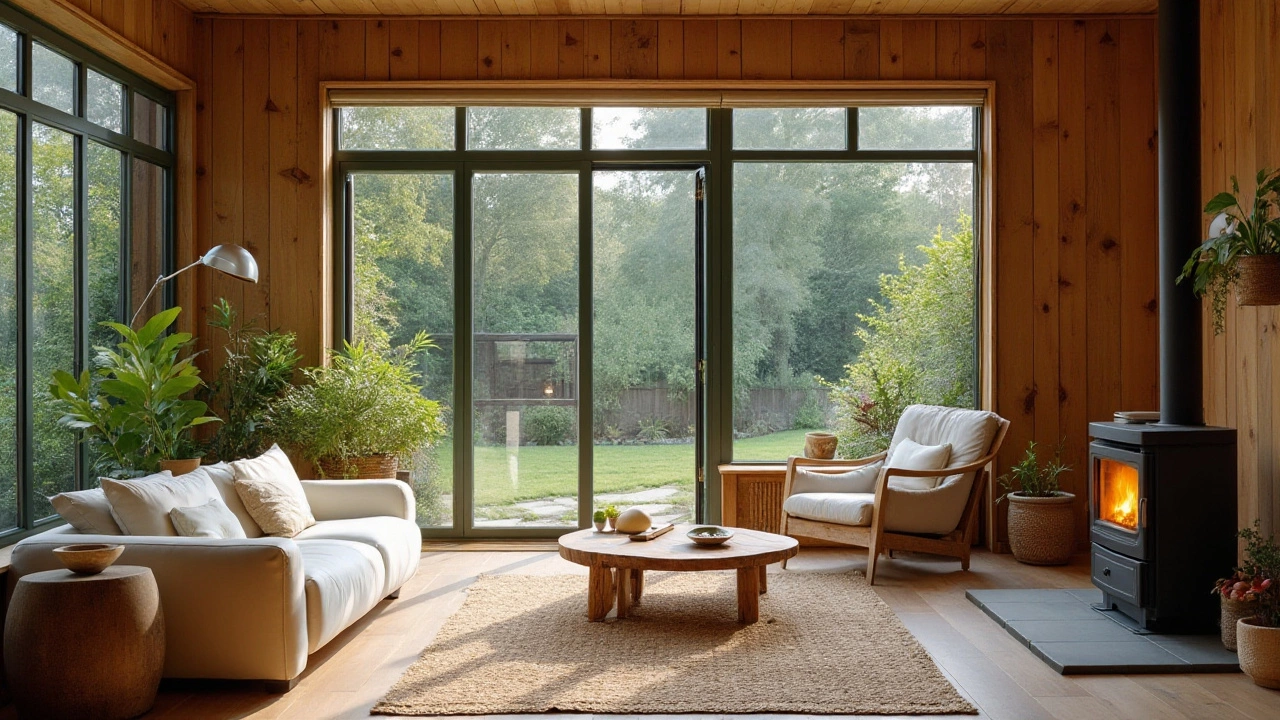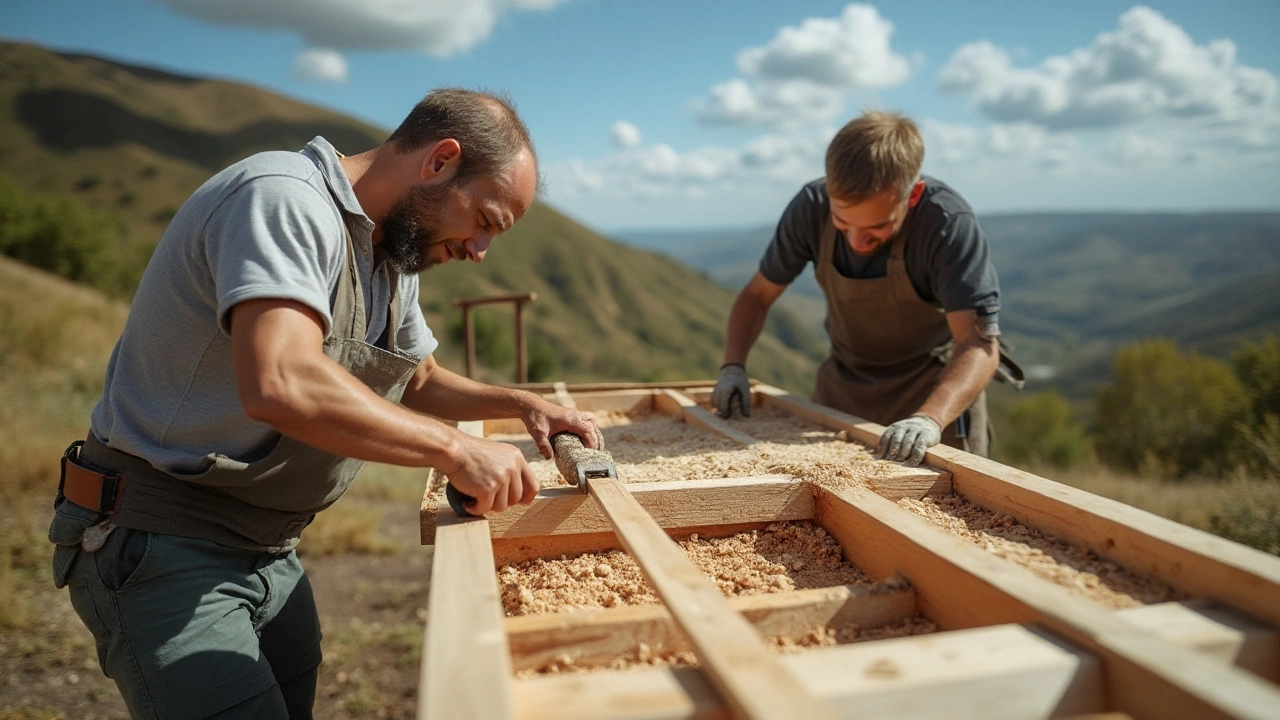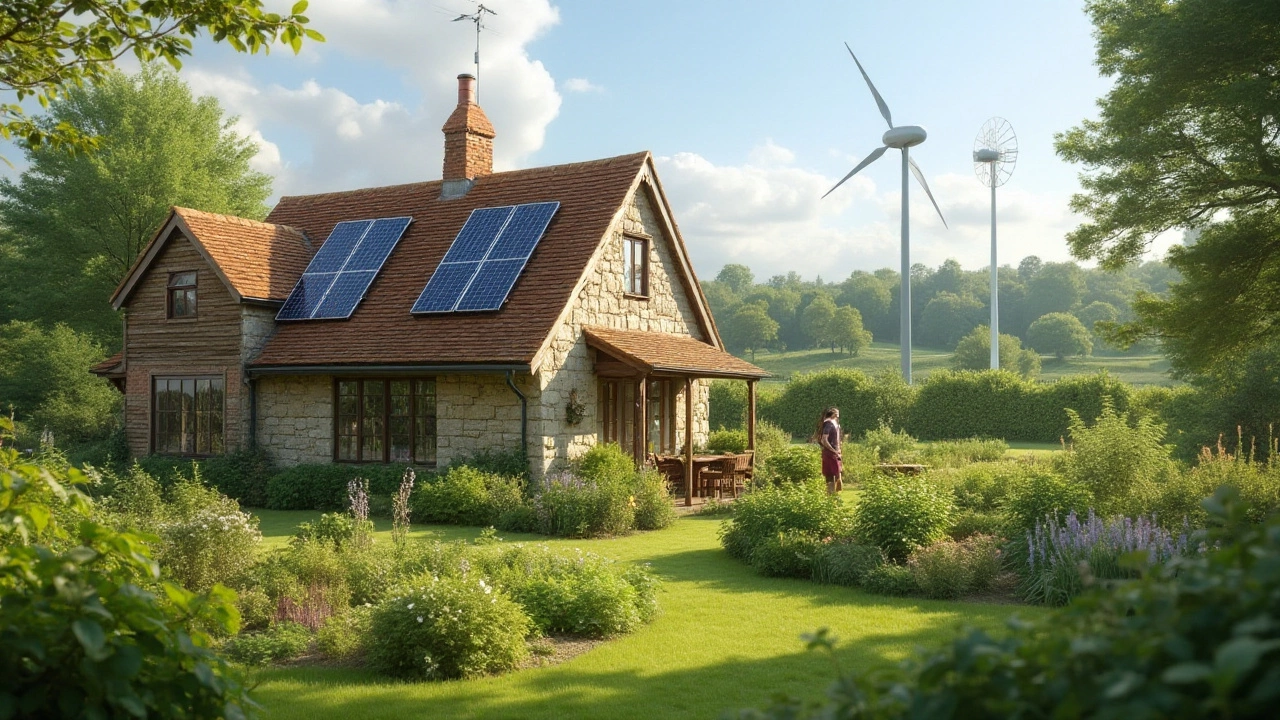Imagine a home that is not only charming but also kind to the earth. Eco-friendly cottages offer just that—a perfect blend of sustainability and aesthetic appeal. In a world increasingly conscious of its ecological footprint, building with nature in mind becomes more than just a trend; it’s a responsibility.
From selecting sustainable materials to integrating energy-saving technologies, constructing a green home is more accessible than ever. These cottages embody the harmony of form and function, proving that sustainable living doesn't mean sacrificing style or comfort.
- Why Choose an Eco-Friendly Cottage
- Sustainable Materials
- Energy Efficiency
- Water Conservation
- Innovative Building Techniques
- Designing for Minimal Impact
Why Choose an Eco-Friendly Cottage
In today’s world, with environmental concerns at the forefront of public consciousness, the decision to build an eco-friendly cottage is more pertinent than ever. The allure of these sustainable homes goes beyond their picturesque charm and extends to their profound environmental benefits. One of the primary reasons to consider such a cottage is its minimal impact on the planet's resources. By choosing eco-friendly materials like recycled wood, bamboo, and hemp, these homes contribute significantly less to deforestation and resource depletion. It emphasizes the need for sustainable living, reducing carbon footprints effectively.
Moreover, eco-friendly cottages often incorporate a range of energy-efficient technologies that not only lessen the strain on natural resources but can also lead to significant cost savings over time. Features such as solar panels, high-efficiency heating systems, and well-insulated windows ensure that energy consumption is kept to a minimum. These innovations align perfectly with the growing global goal of achieving net-zero emissions in residential living. According to the International Energy Agency, buildings and the construction sector are responsible for close to 40% of global energy-related CO2 emissions. Hence, adopting green building practices is crucial for a sustainable future.
Committing to an eco-friendly cottage also means supporting the local economy and encouraging green innovations. Often, builders and suppliers of sustainable materials are small, locally-owned businesses that provide a much-needed boost to regional industries. This not only helps to foster community development but also ensures that the demand for responsibly sourced materials and innovative construction techniques continues to grow. A report published by the World Green Building Council states that “green buildings have a higher asset value, by up to 7%, than their conventional counterparts.”
As noted in a study by the World Resources Institute, "The right choice of materials can reduce a building’s embodied carbon by more than 50%."
Unlike traditional homes, which often require immense upkeep and resources, eco-friendly cottages are designed for longevity and low maintenance. The construction processes and materials ensure that these homes remain resilient against the elements, often featuring self-regenerating facades and roofs that adapt to climate change impacts. Implementing rainwater harvesting systems and composting solutions also introduces a self-sufficient lifestyle, demonstrating how a home can operate symbiotically with its environment. By implementing these practices, homeowners contribute positively to the ecological cycle, creating a ripple effect of environmental stewardship.
Sustainable Materials
In the quest to build the most eco-friendly homes, the choice of materials serves as a seminal factor in the environmental footprint of a house. Materials like bamboo, reclaimed wood, and recycled steel are at the forefront of sustainable building practices. Bamboo is especially favored for its rapid regrowth rate, offering a viable alternative to traditional timber. It grows astonishingly fast, often maturing in just three to five years, compared to decades for hardwood trees. Builders who choose bamboo are adopting a strategy that significantly reduces deforestation pressure.
Reclaimed wood is another shining star in sustainable construction. Unlike new lumber, it doesn’t necessitate further tree harvesting, promoting resource conservation. Its aesthetic appeal, with a distinct character and history often visible in the grain and texture, provides not just physical warmth, but an emotional connection to the past. Builders and homeowners alike cherish using materials that tell a story. Additionally, reclaimed wood can potentially be cheaper than new timber, cutting down on costs while offering a unique design aspect.
Recycled Steel and Its Benefits
Recycled steel is increasingly prevalent in the construction of sustainable cottages. This material brings myriad environmental benefits to the table. Unlike traditional methods, which produce significant CO2 emissions, using recycled steel dramatically curtails environmental pollution. Its strength-to-weight ratio means less material is required, thus minimizing waste. Further, it's non-combustible and resistant to pests, offering a robust and durable structure. In one notable instance, it was found that using recycled steel equivalent to six junk cars can build a single-frame family house. This approach aligns with the broader sustainable ethos of reducing, reusing, and recycling.
"Using sustainable materials isn’t just environmentally sound; it's economically savvy. The market for eco-friendly building is growing tremendously, and resourceful choices are paving the way," says Dr. Jane Sullivan, Professor of Environmental Science.
If you were to craft an eco-friendly cottage, thinking locally could prove beneficial with materials. Straw bale, hempcrete, and cob are locally sourced materials that significantly reduce transportation emissions. Straw bale construction, used since ancient times, ensures excellent insulation - both for temperature and noise. These bales can be sourced from local farms, ensuring your ecological footprint remains small. Similarly, hempcrete, a blend of hemp fibers and lime, provides thermal mass and is incredibly lightweight. Not only does this reduce the carbon output from heating and cooling, but it also supports the agricultural sector.
Many modern constructors are revisiting the past, incorporating traditional building techniques with a modern sensibility. Earthships made from recycled tires, glass bottles, and aluminum cans, challenge the urban sprawl norms by crafting beautiful structures from today’s waste. This not only captures the essence of sustainable living but effectively minimizes landfill impact. The takeaway for eco-conscious builders is clear: integrating green building materials can significantly alter the ecological impact of our homes, reduce carbon footprints, and create spaces that resonate with peace and history.

Energy Efficiency
When building an eco-friendly cottage, paying attention to energy efficiency is not just about reducing utility bills; it’s about preserving our planet’s resources for future generations. By optimizing energy use, one can significantly diminish their carbon footprint, resulting in a greener, more sustainable home. An effective approach is to incorporate passive solar design, which naturally regulates indoor temperatures through strategic window placement and building orientation. This clever use of design minimizes the need for artificial heating and cooling systems, harnessing the sun’s energy to keep your home comfortable year-round without guzzling electricity.
Another critical component is the choice of insulation. High-quality, sustainable insulation materials such as wool, cellulose, or recycled denim ensure that your cottage remains at an optimal temperature, regardless of the weather outside. These materials not only reduce heat loss during winter but also keep the heat out during the summer months. In fact, studies have demonstrated that well-insulated homes can cut heating and cooling costs by up to 50%. Alongside superior insulation, double or triple-glazed windows are also a game changer. They provide an extra layer of protection against temperature fluctuations, enhancing the home's energy savings even further.
Innovations like energy-efficient appliances play a significant role in reducing overall electricity consumption in your green building project. Appliances rated with the ENERGY STAR label meet higher efficiency standards, using less energy without sacrificing performance. Additionally, incorporating smart home technology, such as programmable thermostats and smart lighting systems, brings convenience and sustainability into your daily life. These systems allow homeowners to control environmental settings remotely, ensuring that energy is not wasted when it's least needed.
According to the U.S. Department of Energy, "Heating and cooling account for about 48% of the energy use in a typical U.S. household, making it the largest energy expense for most homes."
In green building practices, integrating renewable energy sources such as solar panels or wind turbines can dramatically lower a home’s dependency on fossil fuels. Solar panels, in particular, have become more affordable over the years, providing households with the ability to generate their electricity from a renewable source. The electricity produced can cover not only daily power needs but can be stored in home battery systems for use during non-sunny days or even sold back to the grid in some regions, providing an additional income stream.
Advanced Lighting Technology
Lighting is another area where major energy savings can be realized. While traditional incandescent bulbs are notoriously inefficient, swapping them out for LED lighting can reduce energy consumption by up to 75%. LED lights have an extended lifespan and, coupled with dimmer switches and sensors, can create a beautifully illuminated home while sparing your wallet and the environment.Building an energy-efficient home is a comprehensive endeavor but one that brings substantial benefits. From design to implementation, every step matters when you are creating a truly sustainable home. With thoughtful planning and modern technology, truly sustainable homes emerge as a beacon of innovation for a greener future, demonstrating that it is possible to live harmoniously with our environment while enjoying modern comforts.
Water Conservation
Water conservation is an essential element of building an eco-friendly cottage, given the increasing concerns over global water resources. The design of a sustainable home often begins with how it manages one of Earth's most vital resources—water. By capturing, storing, and utilizing rainwater effectively, eco-friendly homes manage to significantly reduce their dependency on municipal water supplies. It's not just about turning off faucets when not in use but integrating systematic approaches to manage water use. One popular method involves the installation of rainwater harvesting systems. These systems collect and store rainwater for household uses such as irrigation, laundry, and even potable uses after proper treatment.
Utilizing greywater systems in homes can equally revolutionize the way we think about water usage. Greywater systems divert water from baths, sinks, and washing machines to treat it for outdoor applications, like landscaping, which not only conserves water but also nourishes garden plants. According to studies, implementing such systems can reduce household water consumption by up to 50%. The practice aligns perfectly with living an environmentally responsible lifestyle while enhancing the sustainability of a green building. Furthermore, installing low-flow fixtures for toilets, showers, and faucets is an easy yet impactful way to minimize water usage without sacrificing comfort or efficiency.
While technology plays a role, mindful water management is also about embracing nature. For instance, native landscaping is a sustainable choice as indigenous plants generally require less water, are better adapted to local climates, and support local wildlife. There's a wonder in seeing how, despite the availability of modern engineering solutions, sometimes the best lessons come straight from nature itself. Advocating for intelligent lawn management like mulching and reduced mowing can contribute to less evaporation and improved soil health while conserving water.
Pete Smith, a renowned environmentalist, famously said, "By respecting the water cycle and working with rain instead of against it, not only can we manage a precious resource more effectively, but we cultivate a much healthier, balanced environment." Water conservation does not only create an impact locally but globally, as initiatives in small communities culminate in significant change.
| Water-saving Method | Potential Water Savings |
|---|---|
| Rainwater Harvesting | Up to 40% |
| Greywater Systems | Up to 50% |
| Low-flow Fixtures | About 30% |
| Native Landscaping | Significant reduction in outdoor water use |
It’s important to realize that sustainable homes are more than just physical structures. They are a testament to a lifestyle choice where conservation and ecology are as valuable as design and comfort. For individuals looking to build their own eco-friendly cottage, prioritizing efficient water conservation techniques can lead the charge in setting a sustainable precedent. Water is a precious yet finite resource, and as the challenges of climate change become more apparent, integrating adept water management into our homes is not merely wise—it's an imperative.

Innovative Building Techniques
Building an eco-friendly cottage involves more than just selecting green materials; it requires a shift in approach to the entire construction process. One of the most revolutionary techniques is prefabricated construction. Prefab homes are assembled in sections within a factory setting, minimizing waste and allowing for precision tailoring to your specific design and environmental needs. This method not only speeds up the construction time but significantly lowers the carbon footprint compared to traditional building methods. What's remarkable about prefab technology is how it caters to aesthetic diversity, offering endless possibilities from modern to rustic designs.
Another exciting development is the integration of smart technology to enhance energy efficiency. Today, homes can be equipped with systems that automatically regulate temperature, lighting, and water usage based on your preferences and environmental conditions. This not only promotes conservation but also adds a layer of convenience, making sustainable living effortless. Innovations like solar shingles are transforming rooftops into power generators without compromising on visual appeal. These shingles serve as both water barriers and energy converters, illustrating how far technology has come in blending functionality with sustainability.
Natural building techniques are gaining momentum as well, with practices such as rammed earth construction making a resurgence. This ancient method, which involves compacting natural materials like earth, clay, and gravel, results in walls that are thermally massive and highly durable. The environmental benefits are clear—using local resources reduces transportation emissions, and the energy needed to produce these walls is minimal. It's worth noting that the modern interpretation of rammed earth includes stabilization processes to ensure compliance with today's building standards.
Certain innovative techniques are even drawing inspiration from biomimicry, the practice of mimicking natural systems. For instance, passive solar design strategically places windows and walls to naturally harness heat from sunlight, reducing the need for artificial heating. This approach leverages knowledge from plants and animals that naturally regulate temperature. It’s fascinating how incorporating such biological insights can drive the design of our homes towards more sustainable practices.
"We must recognize that the earth is a living organism, an immense complex of interconnected ecosystems. Our understanding of this interconnectedness is crucial in crafting homes that respect and harmonize with their surroundings," said Amory Lovins, a noted physicist and environmentalist known for his work on resource-efficient building techniques.
To add another layer to sustainable homes, recycled materials are being ingeniously repurposed in construction. Shipping containers, which often end up as waste, are being transformed into modern living spaces. These sturdy metal boxes are perfect for creating modular homes that are durable, stylish, and portable. This sort of adaptive reuse not only diverts waste from landfills but also breathes new life into materials that would otherwise remain unused. As we look to the future, the continuous cross-pollination of ideas across disciplines holds the key to evolving even more cutting-edge techniques, driving the dream of a truly sustainable habitat forward.
Designing for Minimal Impact
In the quest to construct the greenest homes, eco-friendly design is pivotal. When planning a cottage that harmonizes with the environment, it's essential to focus on reducing the ecological footprint. Designing for minimal impact means considering every aspect, from the building's orientation to the materials used. By strategically positioning a cottage to take advantage of natural light and ventilation, energy consumption can be significantly reduced. This not only lowers utility bills but also decreases reliance on non-renewable resources, aligning with sustainable practices.
Think about the surrounding ecosystem during the planning phase. Imagine a cottage that blends effortlessly into its environment, using the land's natural features to its advantage. Incorporating native plants into the landscaping not only enhances aesthetics but also supports local wildlife. A well-designed sustainable home minimizes land disturbance, protecting vital habitats. Rainwater harvesting systems and green roofs are also innovative ways to integrate the natural landscape into the building's design, contributing to water conservation and insulation.
The choice of building materials plays a crucial role in reducing impact. Opt for locally sourced and recycled materials whenever possible. Using reclaimed wood or recycled metal not only gives these materials a new life but also cuts down on the emissions associated with transporting goods over long distances. Additionally, consider the thermal properties of the materials chosen. Insulation made from recycled denim or sheep's wool provides excellent thermal performance, further reducing energy needs for heating and cooling. As the famous architect Frank Lloyd Wright once said,
"Study nature, love nature, stay close to nature. It will never fail you."This quote perfectly captures the essence of building in harmony with nature.
Moreover, technology meets tradition in modern eco-design. Incorporating solar panels or small wind turbines can make a significant difference in a cottage’s energy usage. Smart technology can manage energy use more efficiently, optimizing heating, lighting, and cooling systems in real-time. It's this beautiful blend of cutting-edge innovation and timeless efficiency that sets modern green building practices apart. While it might seem daunting to integrate all these features, taking a step-by-step approach allows homeowners to create a low-impact home that is both feasible and inspiring.
Lastly, reflect on the longevity of the design. Durability is a cornerstone of sustainable buildings. Thoughtfully chosen designs and materials mean fewer repairs and replacements down the line, translating to fewer resources used and waste generated. Life cycle analysis is a tool that examines the environmental impact of a product over its lifetime. By choosing materials and designs with this approach in mind, eco-conscious builders can ensure their cottages are built to last while treading lightly on the Earth.
